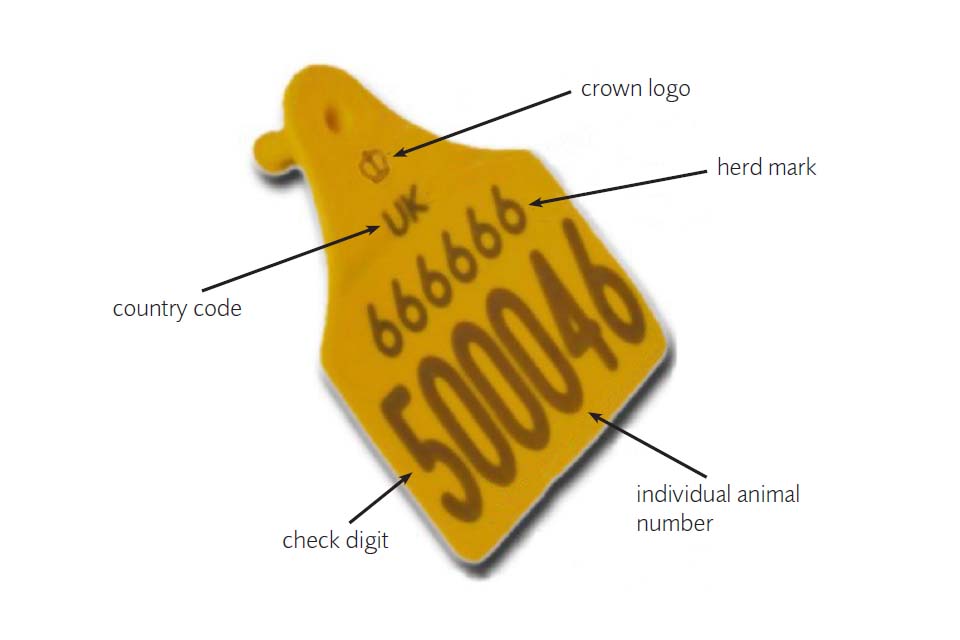What to do after a calf is born
Cattle keepers must tag newborn calves, apply for passports and enter the correct details in the holding register.
Applies to England and Wales
When a calf is born, the keeper must comply with the cattle identification regulations, which include:
- ensuring it is fitted with an approved ear tag in each ear by the legal deadlines
- applying for a cattle passport within the legal deadlines
- entering the calf’s details in the holding register
What tags to use
Each calf needs one primary and one secondary ear tag, both showing the same unique individual identification number.
Primary ear tags
The primary tag must be a yellow plastic distance-readable flag tag. It can go in either ear.
Each part of the primary tag must only contain:
- the crown logo
- the country code (‘UK’)
- the herd mark
- a 6 digit individual animal number

Primary ear tag
Secondary ear tags
A secondary tag must:
- be in the other ear from the primary tag
- contain the same official identity information as the primary tag
A secondary tag can also:
- contain management information
- be a different size or style from the primary tag
- be made of metal or plastic
If you add management information to the tag, it must not affect or confuse the official identification information on it.
When to tag newborn calves and apply for cattle passports
You cannot move a calf off a holding without the correct ear tags in place and without a passport (except in exceptional circumstances on welfare grounds, in which case you must apply for a movement licence by contacting BCMS).
You do not have to apply both tags at the same time and you can choose whether to fit the primary or the secondary tag first.
| Calf type | Deadline for fitting first tag | Deadline for fitting second tag | Deadline for getting passport application to BCMS |
|---|---|---|---|
| Dairy | Within 36 hours of birth | Up to 20 days from birth | Within 27 days of birth |
| Beef | Up to 20 days from birth | Up to 20 days from birth | Within 27 days of birth |
| Bison | Within 9 months of birth, or before weaning, whichever is sooner | Within 9 months of birth, or before weaning, whichever is sooner | Within 7 days of birth |
If an untagged calf dies before these deadlines
You do not need to tag it, but you must record its date of birth and date of death against the dam number in your holding register.
If you keep cattle for cultural and historical use
If you keep cattle on a holding that is registered for cultural and historical use (except for fairs and exhibitions), you may be permitted to use an electronic identifier in the form of a bolus instead of ear tags. Contact BCMS for advice.
Fitting tags safely
You should take care when handling cattle at all times, including when applying ear tags. You should ensure you have sufficiently safe handling facilities to undertake tagging within the statutory requirements.
The Health and Safety Executive’s publication ‘Handling and housing cattle’ can help you, as can the cattle welfare codes for England and Wales.
Contact BCMS immediately if you have problems with tagging your cattle.
What to enter in your holding register
You should record the newborn calf’s:
- ear tag number
- date of birth
- sex
- breed
- birth dam’s ear tag number
- sire’s ear tag number (if known)
Contact BCMS
British Cattle Movement Service
Curwen Road
Derwent Howe
Workington
Cumbria
CA14 2DD
Email bcmsenquiries@rpa.gov.uk
BCMS helpline 0345 050 1234
Helpline for cattle keepers in Wales 0345 050 3456
Normal BCMS helpline opening hours: Monday to Friday 8:30am to 5pm, closed weekends and bank holidays. All calls charged at local rate.
Last updated 4 October 2021 + show all updates
-
This guidance has been updated to show it no longer applies to Scotland.
-
First published.